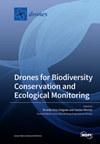Quantifying Within-Flight Variation in Land Surface Temperature from a UAV-Based Thermal Infrared Camera
IF 4.4
2区 地球科学
Q1 REMOTE SENSING
引用次数: 0
Abstract
Land Surface Temperature (LST) is a key variable used across various applications, including irrigation monitoring, vegetation health assessment and urban heat island studies. While satellites offer moderate-resolution LST data, unmanned aerial vehicles (UAVs) provide high-resolution thermal infrared measurements. However, the continuous and rapid variation in LST makes the production of orthomosaics from UAV-based image collections challenging. Understanding the environmental and meteorological factors that amplify this variation is necessary to select the most suitable conditions for collecting UAV-based thermal data. Here, we capture variations in LST while hovering for 15–20 min over diverse surfaces, covering sand, water, grass, and an olive tree orchard. The impact of different flying heights and times of the day was examined, with all collected thermal data evaluated against calibrated field-based Apogee SI-111 sensors. The evaluation showed a significant error in UAV-based data associated with wind speed, which increased the bias from −1.02 to 3.86 °C for 0.8 to 8.5 m/s winds, respectively. Different surfaces, albeit under varying ambient conditions, showed temperature variations ranging from 1.4 to 6 °C during the flights. The temperature variations observed while hovering were linked to solar radiation, specifically radiation fluctuations occurring after sunrise and before sunset. Irrigation and atmospheric conditions (i.e., thin clouds) also contributed to observed temperature variations. This research offers valuable insights into LST variations during standard 15–20 min UAV flights under diverse environmental conditions. Understanding these factors is essential for developing correction procedures and considering data inconsistencies when processing and interpreting UAV-based thermal infrared data and derived orthomosaics.基于无人机热红外相机的地表温度飞行内变化量化研究
地表温度(LST)是广泛应用于灌溉监测、植被健康评估和城市热岛研究等领域的关键变量。卫星提供中等分辨率的地表温度数据,而无人机提供高分辨率的热红外测量。然而,地表温度的持续快速变化使得从基于无人机的图像集合中产生正立体图具有挑战性。了解放大这种变化的环境和气象因素对于选择最合适的条件来收集基于无人机的热数据是必要的。在这里,我们在不同的表面上悬停15-20分钟,捕捉到地表温度的变化,覆盖沙子、水、草地和橄榄树果园。研究人员检查了不同飞行高度和飞行时间的影响,并利用校准过的现场Apogee SI-111传感器评估了所有收集到的热数据。评估显示,基于无人机的数据与风速相关存在显著误差,在0.8至8.5 m/s风速下,偏差分别从- 1.02°C增加到3.86°C。在不同的环境条件下,不同的表面在飞行过程中显示出1.4到6°C的温度变化。盘旋时观测到的温度变化与太阳辐射有关,特别是日出后和日落前的辐射波动。灌溉和大气条件(即薄云)也有助于观测到的温度变化。这项研究为不同环境条件下标准15-20分钟无人机飞行期间的LST变化提供了有价值的见解。在处理和解释基于无人机的热红外数据和衍生的正交图像时,了解这些因素对于制定校正程序和考虑数据不一致性至关重要。
本文章由计算机程序翻译,如有差异,请以英文原文为准。
求助全文
约1分钟内获得全文
求助全文

 求助内容:
求助内容: 应助结果提醒方式:
应助结果提醒方式:


